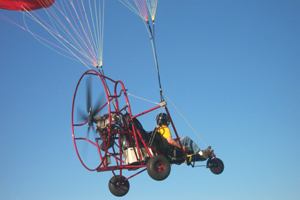Propellers for Powered Parachutes
Powered parachutes represent the fastest growing segment of the ultralight community. In the late 1980's there were only a few companies making the machines. Now, there are more companies and more models of this flying mode than any other flying machine.
There are two basic types in this category. The simplest is the “back pack”, where you are the fuselage and undercarriage or landing gear. They are foot launched. The small engine and prop are harnessed on your back like a hiker's backpack. A throttle in one hand, the parachute turning controls in both and with a small canopy above you, prepare to have the most fun and freedom you can imagine!
The other type has all the comforts of standard trikes or ultralights. It has a frame, undercarriage, seat, instrument panel and other luxuries you want or can afford. It naturally has a larger canopy, engine and prop and costs a lot more than its simple brethren.
Powered parachute popularity stems from several sources. Foremost is the ease of flying one. The throttle controls climbing and altitude. Full power to climb, reduced power to hold altitude and cruise, lower power to descend and land. Like a snow sled, turning is accomplished by pushing a control bar with your feet (or hands in the case of backpacks). The only downsides to flying these simple machines are they are slow, their speed fixed by the canopy design, and limited to the 30 mph range. Additionally, they are best launched with help from a ground crew to get the canopy properly inflated. With the right field and wind conditions and with experience, self launching is possible. Finally, since the machines must take off and land very nearly into the wind for best safety, an “aerodrome” or large field is necessary. A runway or two will usually not suffice.
The Ultra-Prop was the standard prop for many powered parachute models in the 80's and 90's. Buckeye, SixChuter and other pioneers chose the Ultra-Prop for its low cost, smoothness, durability and performance. With the diameter limitations of the prop cages and smaller engines of the day, it was the best prop available.
Today, many models have very large and expensive engines, requiring larger diameter, higher cost props than the standard Ultra-Prop I. For smaller units and for backpacks the Ultra-Prop I still fills many requirements. For larger engines and units with clearance for bigger diameter propellers, the Ultra-Prop II can fill the needs.
Contact us for our recommendations for other applications.



